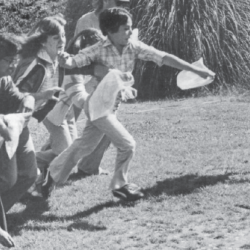Source Institutions
Source Institutions
Add to list Go to activity
Activity link broken? See if it's at the internet archive

In this outdoor game, learners simulate a herd of deer trying to survive in an area called the "home range." Learners explore the concept of "carrying capacity"—what size population of an organism can be supported by the food supply in the organism's home range. The game simulates five years in the life of a deer herd, with changing factors such as the addition of new young deer, the reduction of food sources, and dispersal of the herd to new feeding areas. Learners consider similarities and differences between deer and human populations over time, and the impact of humans feeding wild herds. A white board or large sheet of paper can serve as the data board.
- 10 to 30 minutes
- 45 to 60 minutes
- $5 - $10 per group of students
- Ages 8 - 14
- Activity, Game, Simulation
- English
Quick Guide
Materials List (per group of students)
- 10 home-range poker chips (one color) per learner
- 6 new-range poker chips (another color) per learner
- 4 plastic sandwich bags per learner
- flagging or cord for marking home-range boundaries
- 1 kitchen timer or watch with second hand
- 1 data board and marking pen
Subjects
-
Life Sciences
-
Diversity of Life
- Animals
-
Ecology
- Populations
-
Diversity of Life
-
The Nature of Science
-
The Scientific Process
- About Inquiry
- Asking Questions
- Conducting Investigations
- Gathering Data
- Formulating Explanations
- Communicating Results
-
The Scientific Process
Informal Categories
- Animals
- Games
- Nature and Environment
- Outdoor Activity
- Physical Activity
Audience
To use this activity, learners need to:
- see
- see color
- be mobile
- touch
Learning styles supported:
- Involves teamwork and communication skills
- Involves hands-on or lab activities
Other
This resource is part of:
Access Rights:
- Free access
By:
Rights:
- All rights reserved, The Regents of the University of California, 1980
